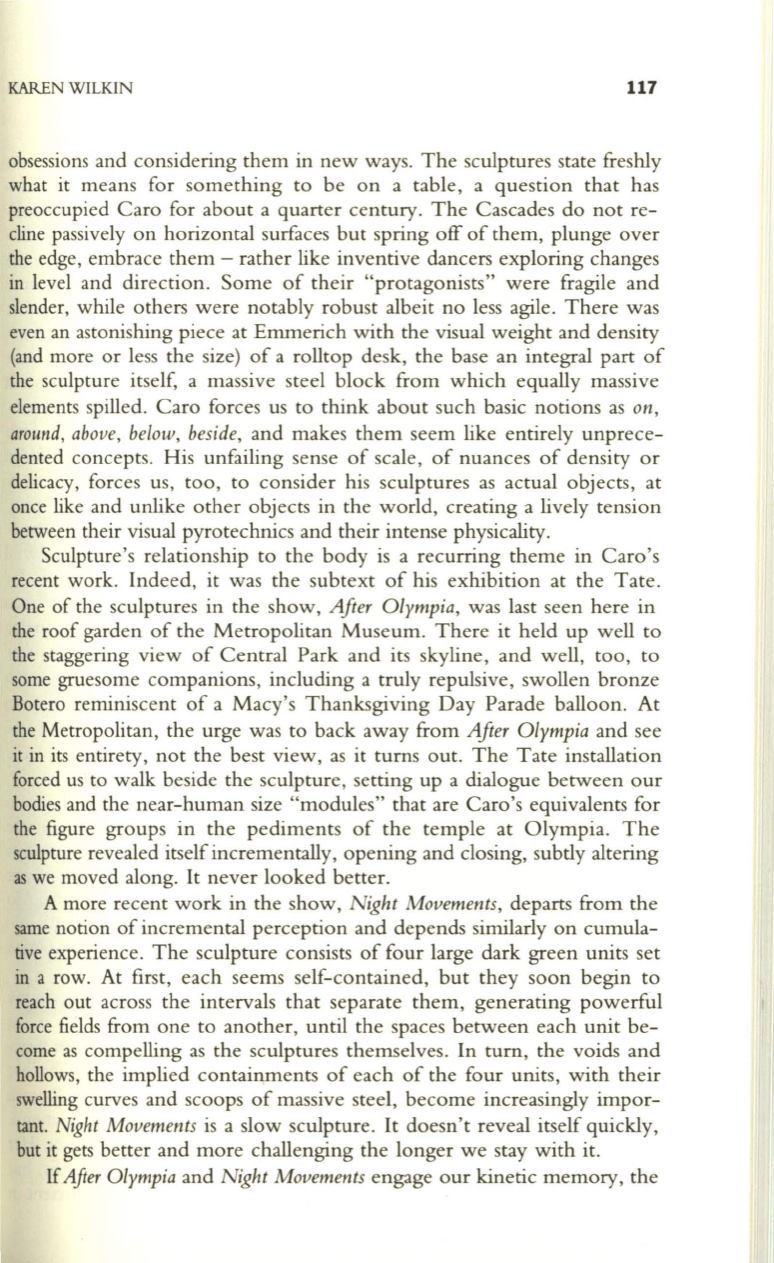
KAREN WILKlN
117
obsessions and considering them in new ways. The sculptures state freshly
what it means for something to be on a table, a question that has
preoccupied Caro for about a quarter century. The Cascades do not re–
cline passively on horizontal surfaces but spring off of them, plunge over
the edge, embrace them - rather like inventive dancers exploring changes
in level and direction . Some of their "protagonists" were fragile and
slender, while others were notably robust albeit no less agile. There was
even an astonishing piece at Emmerich with the visual weight and density
(and more or less the size) of a rolltop desk, the base an integral part of
the sculpture itself, a massive steel block from which equally massive
elements spilled. Caro forces us to think about such basic notions as
on,
around, above, below, beside,
and makes them seem like entirely unprece–
dented concepts. His unfailing sense of scale, of nuances of density or
delicacy, forces us, too, to consider his sculptures as actual objects, at
once like and unlike other objects in the world, creating a lively tension
between their visual pyrotechnics and their intense physicality.
Sculpture's relationship to the body is a recurring theme in Caro's
recent work. Indeed, it was the subtext of his exhibition at the Tate.
One of the sculptures in the show,
After Olympia,
was last seen here in
the roof garden of the Metropolitan Museum. There it held up well to
the staggering view of Central Park and its skyline, and well, too, to
some gruesome companions, including a truly repulsive, swollen bronze
Botero reminiscent of a Macy's Thanksgiving Day Parade balloon. At
the Metropolitan, the urge was to back away from
After Olympia
and see
it in its entirety, not the best view, as it turns out. The Tate installation
forced us to walk beside the sculpture, setting up a dialogue between our
bodies and the near-human size "modules" that are Caro's equivalents for
the figure groups in the pediments of the temple at Olympia. The
sculpture revealed itself incrementally, opening and closing, subtly altering
as we moved along.
It
never looked better.
A more recent work in the show,
Night Movements,
departs from the
same notion of incremental perception and depends similarly on cumula–
tive experience. The sculpture consists of four large dark green units set
in a row. At first, each seems self-contained, but they soon begin to
reach out across the intervals that separate them, generating powerful
force fields from one to another, until the spaces between each unit be–
come as compelling as the sculptures themselves. In turn, the voids and
hollows, the implied containments of each of the four units, with their
swelling curves and scoops of massive steel, become increasingly impor–
tant.
Night Movements
is a slow sculpture.
It
doesn't reveal itself quickly,
but it gets better and more challenging the longer we stay with it.
If
After Olympia
and
Night Movements
engage our kinetic memory, the


